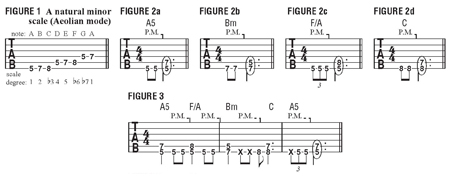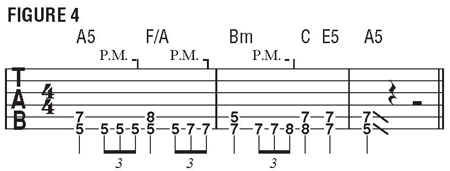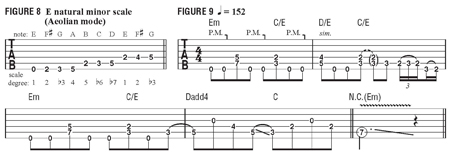Metal For Life: Power Surge

How to build power chord variations for maximum sonic effect.
My students often ask me how they can break away from typical root-fifth power chord rhythm figures. My solution is to devise a variety of different two-note chord shapes—built from pairs of notes, like root-fifth power chords—that sound great when applied to metal, even though these chord shapes can be used in virtually every style of guitar-based music.
To me, the simplest and most effective way to do this is to first take a look at metal’s most commonly used scale, natural minor, and then create note pairings built from various degrees of that scale.

FIGURE 1 shows the A natural minor scale (also known as the A Aeolian mode) in fifth position. The idea is to build two-note chords from different combinations of these scale degrees: FIGURE 2a illustrates a standard root-fifth A5 power chord, which combines the root note, A, and the fifth, E. FIGURE 2b combines B and D to create a two-note B minor chord voicing, FIGURE 2c combines A and F to create F/A, and FIGURE 2d combines C and E to create a C voicing. FIGURE 3 shows these chords used within the context of a progression.

Now, let’s create metal-style rhythm parts that use these two-note voicings. In FIGURE 4, I play the same chord progression but add palm-muted eighth-note triplet accents on the bass note of each chord throughout. Also, I’ve added one more two-note voicing, E5, sounded by barring the index finger across the bottom two strings at the seventh fret.

Let’s apply this concept to a hard-driving rhythm part. In FIGURE 5, I add palm-muted eighth-note accents on the bass note of each chord, creating a syncopated feel by accenting many of the power chords on the eighth-note upbeats.

Many metal bands feature a two-guitar lineup, and often the guitarists will play the same rhythm part but use different chord voicings to fill out the sound. FIGURE 6 represents the same rhythm pattern shown in FIGURE 5 but uses open strings and second-position chords.

Another twist is to displace one of the notes of a two-note pair an octave higher, which will change the sound and texture of the chord dramatically while retaining its underlying harmonic quality. In FIGURE 7, I again play the same progression but change the C chord voicing by moving the C note up one octave so that the chord becomes C/E.

Now let’s apply this concept to another key. FIGURE 8 shows the E natural minor scale (E F# G A B C D), and FIGURE 9 depicts a chord sequence devised of two-note shapes built from this scale. There are only three different chord voicings used in this example—Em, C/E and D/E, all played against the open low-E string pedal tone. The only deviation is found in bar 4, wherein I incorporate the open G string to fill out the sound, resulting in the Dadd4 and C chord voicings.
Get The Pick Newsletter
All the latest guitar news, interviews, lessons, reviews, deals and more, direct to your inbox!
“There are so many sounds to be discovered when you get away from using a pick”: Jared James Nichols shows you how to add “snap, crackle and pop” to your playing with banjo rolls and string snaps
Don't let chord inversions bamboozle you. It's simply the case of shuffling the notes around







![Joe Bonamassa [left] wears a deep blue suit and polka-dotted shirt and plays his green refin Strat; the late Irish blues legend Rory Gallagher [right] screams and inflicts some punishment on his heavily worn number one Stratocaster.](https://cdn.mos.cms.futurecdn.net/cw28h7UBcTVfTLs7p7eiLe.jpg)


